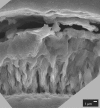The leucine-rich amelogenin peptide alters the amelogenin null enamel phenotype
- PMID: 18701811
- PMCID: PMC2824192
- DOI: 10.1159/000151384
The leucine-rich amelogenin peptide alters the amelogenin null enamel phenotype
Abstract
Introduction: The amelogenin proteins secreted by ameloblasts during dental enamel development are required for normal enamel structure. Amelx null (KO) mice have hypoplastic, disorganized enamel similar to that of human patients with mutations in the AMELX gene, and provide a model system for studies of the enamel defect amelogenesis imperfecta. Because many amelogenin proteins are present in developing enamel due to RNA alternative splicing and proteolytic processing, understanding the function of individual amelogenins has been challenging.
Purpose: Our objective was to better understand the role of LRAP, a 59 amino acid leucine-rich amelogenin peptide, in the development of enamel.
Approach: Teeth from transgenic mice that express LRAP under control of the Amelx regulatory regions were analyzed for mechanical properties, and transgenic males were mated with female KO mice. Male offspring with a null background that were transgene positive or transgene negative were compared to determine phenotypic differences using microcomputed tomography (microCT) and scanning electron microscopy (SEM).
Results: Nanoindentation revealed no differences between LRAP transgenic and wild-type murine enamel. Using microCT, LRAPKO enamel volume and density measurements were similar to those from KO mice. However, in etched samples examined by SEM, the organization of the enamel rod pattern was altered by the presence of the LRAP transgene.
Conclusions: The presence of LRAP leads to changes in enamel appearance compared to enamel from KO mice. Expression of a combination of amelogenin transgenes in KO mice may lead to rescue of the individual characteristics of normal enamel.
Copyright 2008 S. Karger AG, Basel.
Figures




Similar articles
-
Rescue of the murine amelogenin null phenotype with two amelogenin transgenes.Eur J Oral Sci. 2011 Dec;119 Suppl 1(Suppl 1):70-4. doi: 10.1111/j.1600-0722.2011.00882.x. Eur J Oral Sci. 2011. PMID: 22243230 Free PMC article.
-
The small bovine amelogenin LRAP fails to rescue the amelogenin null phenotype.Calcif Tissue Int. 2003 Nov;73(5):487-95. doi: 10.1007/s00223-002-0036-7. Epub 2003 Sep 10. Calcif Tissue Int. 2003. PMID: 12958690
-
M180 amelogenin processed by MMP20 is sufficient for decussating murine enamel.J Dent Res. 2013 Dec;92(12):1118-22. doi: 10.1177/0022034513506444. Epub 2013 Sep 26. J Dent Res. 2013. PMID: 24072097 Free PMC article.
-
The use of animal models to explore amelogenin variants in amelogenesis imperfecta.Cells Tissues Organs. 2005;181(3-4):196-201. doi: 10.1159/000091381. Cells Tissues Organs. 2005. PMID: 16612085 Review.
-
[Alteración del gen AMELX en amelogénesis imperfecta. Una breve revisión].Gac Med Mex. 2019;155(1):101-107. doi: 10.24875/GMM.18003604. Gac Med Mex. 2019. PMID: 30799455 Review. Spanish.
Cited by
-
Leucine rich amelogenin peptide alters ameloblast differentiation in vivo.Matrix Biol. 2013 Oct-Nov;32(7-8):432-42. doi: 10.1016/j.matbio.2013.05.004. Epub 2013 Jun 4. Matrix Biol. 2013. PMID: 23747796 Free PMC article.
-
Analysis of enamel development using murine model systems: approaches and limitations.Front Physiol. 2014 Sep 17;5:313. doi: 10.3389/fphys.2014.00313. eCollection 2014. Front Physiol. 2014. PMID: 25278900 Free PMC article. Review.
-
Consequences for enamel development and mineralization resulting from loss of function of ameloblastin or enamelin.Eur J Oral Sci. 2009 Oct;117(5):485-97. doi: 10.1111/j.1600-0722.2009.00666.x. Eur J Oral Sci. 2009. PMID: 19758243 Free PMC article.
-
Mutations Causing X-Linked Amelogenesis Imperfecta Alter miRNA Formation from Amelogenin Exon4.J Dent Res. 2023 Oct;102(11):1210-1219. doi: 10.1177/00220345231180572. Epub 2023 Aug 10. J Dent Res. 2023. PMID: 37563801 Free PMC article.
-
Rescue of the murine amelogenin null phenotype with two amelogenin transgenes.Eur J Oral Sci. 2011 Dec;119 Suppl 1(Suppl 1):70-4. doi: 10.1111/j.1600-0722.2011.00882.x. Eur J Oral Sci. 2011. PMID: 22243230 Free PMC article.
References
-
- Boabaid F., Gibson C.W., Kuehl M.A., Berry J.E., Snead M.L., Nociti F.H., Jr., Katchburian E., Somerman M.J. Leucine-rich amelogenin peptide: a candidate signaling molecule during cementogenesis. J Periodontol. 2004;75:1126–1136. - PubMed
-
- Chapman V.M., Keitz B.T., Disteche C.M., Lau E.C., Snead M.L. Linkage of amelogenin (Amel) to the distal portion of the mouse X chromosome. Genomics. 1991;10:23–28. - PubMed
-
- Chen E., Yuan Z.A., Wright J.T., Hong S.P., Li Y., Collier P.M., Hall B., D'Angelo M., Decker S., Piddington R., Abrams W.R., Kulkarni A.B., Gibson C.W. The small bovine amelogenin LRAP fails to rescue the amelogenin null phenotype. Calcif Tiss Int. 2003;73:487–495. - PubMed
-
- Delgado S., Ishiyama M., Sire J.-Y. Validation of amelogenesis imperfecta inferred from amelogenin evolution. J Dent Res. 2007;86:326–330. - PubMed
-
- Deutsch D., Haze-Filderman A., Blumenfeld A., Dafni L., Leiser Y., Shay B., Gruenbaum-Cohen Y., Rosenfeld E., Fermon E., Zimmermann B., Haegewald S., Bernimoulin J.P., Taylor A.L. Amelogenin, a major structural protein in mineralizing enamel, is also expressed in soft tissues: brain and cells of the hematopoietic system. Eur J Oral Sci. 2006;114(suppl 1):183–189. - PubMed
Publication types
MeSH terms
Substances
Grants and funding
LinkOut - more resources
Full Text Sources
Research Materials

